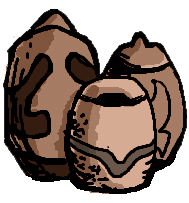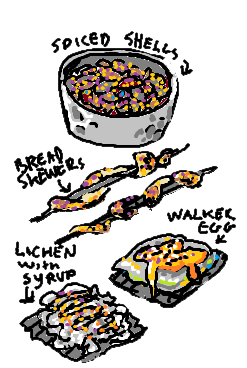The culinary practices of
nomads of Mercury have a profound impact on the areas they travel through. Wherever they travel, they bring foods and seeds with them. The impact of these nomadic peoples can be mapped in the spread of nutrient rich foods like the plumfingers, Mercurian bark beetles and edible lichen throughout
Mercury.
Staples of Nomadic Cuisine
Staples of nomadic cuisine include walker eggs, fried bugs, bug flour, roots, lichen and plumfingers. Nomadic
Kara and
Mori also consume plant pulp and wood flour.
Walker Eggs
Walker eggs are rich in yolk and fats. They're fried and eaten on their own.
One nomadic delicacy involves introducing a local non-toxic mold to a cooked egg to ferments it, giving the egg a unique aged flavour.
Bug Flour
Bug flour is made by grinding bugs, creating a protein rich base for making bread.
It is popular to mash padi from supply drops and mix it with bug flour. The resulting dough is then fried as patties. The patties are eaten as is, or used in soup as dumplings.
Plumfingers
Plumfingers are Mercurian succulents with a deep purple colour. They are sharply flavoured when raw, but caramelize and become very sweet upon cooking.
Plumfingers are sometimes jammed or made into syrups.
Salt
Salt is emerging as a staple for the Mercurian nomads, but for purposes of trade rather than cooking. As the oceans of Mercury have evaporated into salt flats, salt has become abundant and easy to harvest. The Halobate people in particular have dedicated themselves to the harvest and trade of the eponymous
Halobate Salt, collaborating with a venusian company to export and sell the salt on the interplanetary market.
Despite not really being used by the nomads themselves, Halobate salt has become a symbol of the nomads of Mercury and a way of showing support for the plight of the planet.
Nomadic Agriculture
The nomads of Mercury practice ancient forms of agriculture like abundance havesting, egg jars and food forests. These methods all rely on cultivating the enviroment for future harvests, and encouraging self-sustaining growth. These practices have been influential to the ideas of polycropped agriculture (as opposed to monocrops), and to permaculture at large.
Abundance Harvesting
Abundance harvesting, sometimes also called plenty harvesting, is a method of harvesting that not only ensures the plant will grow back, but that it will grow back even more abundant than last year. Part of the practice is to never harvest more than a tenth of the crop, or to harvest so that it is not visible that you took anything.
As the natural food stores of Mercury are dwindling, many nomads find themselves making a difficult choice in whether to harvest for this year or next.
Egg Jars
Egg jars are made
Walker potter eggs, but the name also evokes the nomadic origin myth of the World Egg. These jars contain seeds and colonies of bugs, and are used to create new food sources.
Usually the egg jars are maintained and used by the elders of the nomadic group. It is their job to pick out suitable enviroments to grow these new foods.

Potter Eggs by Annie Stein
Food Forests
One of the nomadic people prevalent around the equator of Mercury were well known for cultivating food forests using a method known as the Seven Cultures. The Seven Cultures are seven different groupings of food that grow well together, either by providing nutrients that another crop needs or protecting them from pests. These seven cultures are seperate for different densities of forest, from cultures meant to grow under the canopies of fully developed trees, to cultures meant to grow between the grasses.
Adapting to a New World
The loss of enviroment from the
Scorching of Mercury makes many of the practices of the nomads harder to sustain, as food is becoming ever rarer. Still, the nomads are trying to regrow the planet, and are succeeding at finding new ways to harvest and train the enviroments. It has been a time of great innovation. They have discovered a way of encouraging and harvesting complex root systems deep enough in the dirt to avoid scorching. They have also focused on finding ways to eat the hardier plants and wildlife that remain.
One popular and highly successful practice is the cultivation of shadespots, setting up cairns, tarps and other shelters to block out the sun. This creates small pockets of dirt that resemble Mercury before the loss of atmosphere, with multiple zones of heat. Different plants are cultivated in different spots, and these shadespots also provide great shelter for the remaining wildlife.











Awesome work! I noticed two typos though. At the end of the first Nomadic Agriculture paragraph, you have "alrge" instead of "large." Then in the beginning of Adapting to a New World you have "Normads" instead of nomads lol
Whoops, thank you!